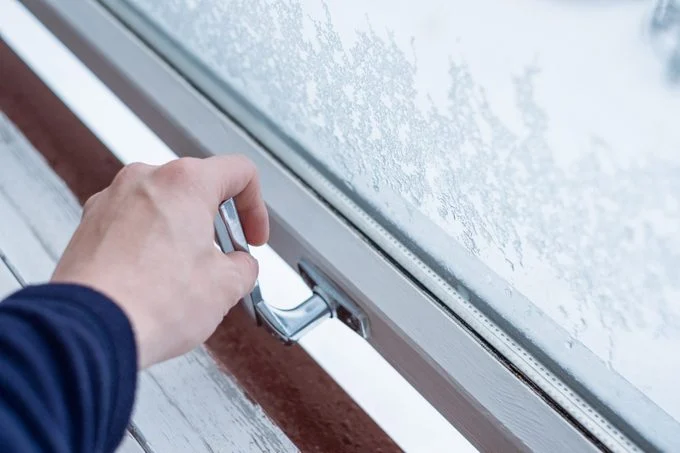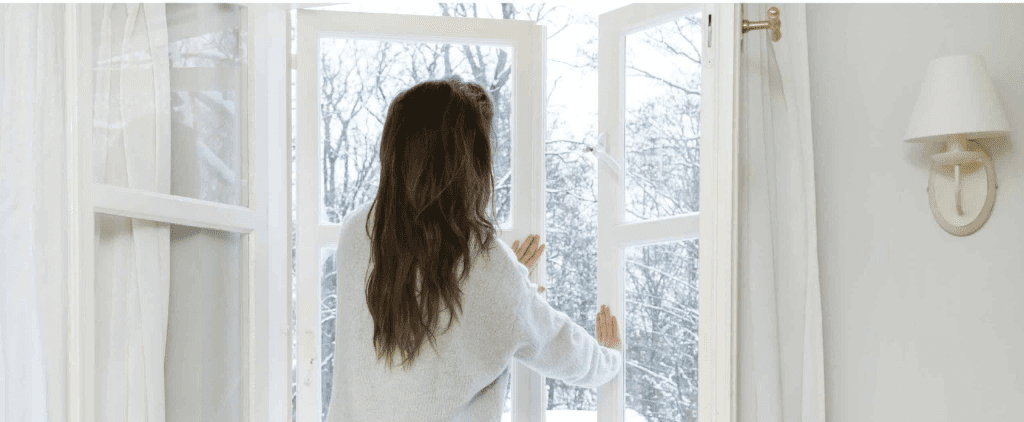On a bitterly cold winter evening at a friend’s house, bundled up in warmth, I noticed something peculiar—a window in the corner, slightly open. With snow drifting outside, it seemed odd to let the cold air seep into an otherwise cozy room. Yet, when I asked about it, my friend explained it was intentional, a choice they made even on the chilliest nights. It turns out this isn’t such an uncommon practice. Let’s explore the reasons behind keeping a window open during winter and why some find it beneficial, while others may see it as strange.
Why Would Anyone Crack a Window Open in Winter?

At first glance, leaving a window ajar during winter seems counterintuitive. After all, isn’t winter about sealing the house up, turning on the heat, and keeping the warmth inside? But this simple act has several surprising benefits that many homeowners appreciate.
1. Improving Indoor Air Quality: The Fresh Air Factor
One of the main reasons people crack open a window, even on the coldest days, is to improve indoor air quality. During winter, our homes are typically sealed tightly to retain heat, which can trap pollutants, dust, and allergens inside. These particles can lower air quality, making the indoor environment stuffy and stagnant. By letting in a bit of fresh air, you improve ventilation, reduce indoor pollutants, and bring a sense of crispness into the room.
- Eliminates Stale Air: Without regular air exchange, indoor air can become stale and laden with odors. A slight breeze refreshes the air, giving the room a cleaner, more pleasant feel.
- Reduces Indoor Pollutants: From cleaning products to cooking fumes and dust, pollutants build up indoors, especially in winter. Briefly opening a window lets them disperse, creating a healthier environment.
2. Regulating Humidity: Preventing Mold and Mildew Growth
In colder months, the air inside our homes can become excessively dry due to heating. However, certain spaces may retain too much moisture, especially bathrooms and kitchens, leading to humidity imbalances. Excess humidity combined with warmth provides an ideal environment for mold and mildew growth, which can damage walls and affect respiratory health. Cracking a window helps maintain proper humidity levels by letting excess moisture escape.
- Humidity Control: Proper ventilation helps balance indoor humidity, discouraging mold growth and keeping the air at a comfortable level.
- Protecting Against Mold: Mold and mildew thrive in moist environments, but letting in a cold breeze can reduce the risk of these nuisances taking hold.
3. Enhanced Sleep Quality: The Benefit of Cooler Air
Did you know that cooler air can improve sleep? Many people find that sleeping in a slightly cooler room helps them rest more deeply, as lower temperatures encourage the body to maintain a stable sleep cycle. If you’ve ever woken up feeling stuffy in a sealed room, it might be due to overheating. Opening a window just a crack before bed can lower the room temperature slightly, making for a more restful night’s sleep.
- Improves Sleep Temperature: A slightly open window lets in a bit of cold air, which can create a sleep-conducive environment.
- Avoids Overheating: If you wake up feeling hot or stuffy, a small window opening can prevent the discomfort of an overly warm room.
4. Boosting Mental Clarity and Mood
Fresh air isn’t just good for physical health; it can also positively impact mental well-being. For many, the act of letting a little fresh air into the room is refreshing and energizing. The cold winter air carries a unique crispness that can make you feel more awake and alert. This is especially helpful in the morning or during midday slumps when a quick boost can make a difference in energy levels and mental clarity.
- Enhances Focus: Just like taking a brisk walk, the cool air flowing in can help clear your mind.
- Lifts Mood: The freshness of outdoor air may reduce the winter blues and provide a natural mood boost.
5. Cultural and Regional Variations in Ventilation Habits

In some cultures, fresh air is valued for health, and people routinely keep windows open for ventilation, even during winter. Countries in Scandinavia, for example, embrace fresh air year-round and frequently keep windows open to reduce stale air indoors. In other regions, conserving energy and staying warm take priority, making the practice less common. This regional variation shows that the choice to keep a window open during winter often depends on cultural habits, personal health beliefs, and climate.
- Scandinavian Influence: Many Scandinavian households prioritize fresh air, seeing it as essential for health.
- Energy Conservation: In colder or more energy-conscious regions, the focus may be on keeping heat indoors to save on heating costs.
6. Potential Downsides: Heat Loss and Energy Concerns
Despite its benefits, keeping a window open during winter comes with some downsides. The most obvious one is heat loss. Opening a window allows precious warm air to escape, which can drive up energy costs. If the open window creates a draft, it can also cause discomfort and even increase the risk of colds if you’re not adequately dressed for the chill. There’s also the risk of outdoor pollutants or allergens entering, especially in urban areas with high traffic pollution.
- Increased Heating Costs: Letting warm air escape makes the heater work harder, which can result in higher bills.
- Drafts and Cold Spots: Drafts can create uncomfortable cold spots in an otherwise warm room, especially if the window isn’t insulated well.
Expert Advice on Balancing Fresh Air and Energy Efficiency

Experts on indoor air quality recommend balanced ventilation during winter to reap the benefits of fresh air while conserving heat. Here are some suggestions for keeping your home fresh and energy-efficient:
- Use Heat Recovery Ventilators: These systems bring in fresh air while recovering the heat from outgoing air, making ventilation more efficient.
- Open Windows Strategically: Choose the least windy side of the house to reduce drafts, or open a window for a few minutes rather than keeping it open all night.
- Consider an Air Purifier: If outdoor air quality is a concern, an air purifier can filter indoor pollutants without the need for open windows.
The Decision Is Personal: What Works for You?
Ultimately, whether or not to keep a window open in winter comes down to personal preference. Some people prioritize fresh air and are happy to sacrifice a bit of warmth for the comfort of knowing the air is circulating. Others might prefer to keep the cold air out entirely, especially if they are more sensitive to temperature or have a home that’s well-sealed for energy efficiency.
Conclusion: Balancing Fresh Air and Comfort in Winter
Leaving a window slightly open on a cold winter night may seem unusual, but it has its benefits. From improved air quality to enhanced sleep and even a mood boost, there are valid reasons for cracking a window, even in freezing weather. However, it’s essential to balance these advantages with the potential downsides, such as heat loss and higher energy costs. Whether for health, comfort, or simply personal preference, keeping a window open during winter is a choice that varies from person to person. By understanding the benefits and drawbacks, you can make the best decision for your home and your comfort this winter.


